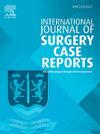Management of adnexal torsion at 23 weeks of pregnancy a case report
IF 0.6
Q4 SURGERY
引用次数: 0
Abstract
Introduction
Adnexal torsion is a rare gynecological emergency, even more exceptional during pregnancy, which can lead to diagnostic delays. Its diagnosis is challenging due to the upward displacement of the ovary in advanced pregnancy, which can mimic other surgical emergencies like appendicitis or pyelonephritis.
Case report
A 27-year-old woman, G1P0 at 23 weeks of gestation, presented with acute pelvic associated with vomiting. Clinical and ultrasound findings revealed a right ovarian torsion on a 60 × 40 mm dermoid cyst. A laparotomy was performed, showing two twists of the ovarian pedicle without ischemia, and a cystectomy was completed, the pregnancy continued to term without complications.
Discussion
Adnexal torsion is a rare emergency in pregnancy), often linked to ovarian pathology like dermoid cysts, as in our cases. Diagnosis is challenging due to nonspecific symptoms and anatomical changes during pregnancy, with ultrasound as the primary tool and MRI for additional precision.
Management depends on gestational age and adnexal viability, with laparoscopy favored before 17 weeks and laparotomy for advanced pregnancies.
Conclusion
Adnexal torsion is difficult to diagnose in pregnancy due to nonspecific symptoms. Prompt diagnostic laparoscopy, following safety guidelines, is crucial for persistent pain unresponsive to treatment to avoid delays.
求助全文
约1分钟内获得全文
求助全文
来源期刊
CiteScore
1.10
自引率
0.00%
发文量
1116
审稿时长
46 days

 求助内容:
求助内容: 应助结果提醒方式:
应助结果提醒方式:


